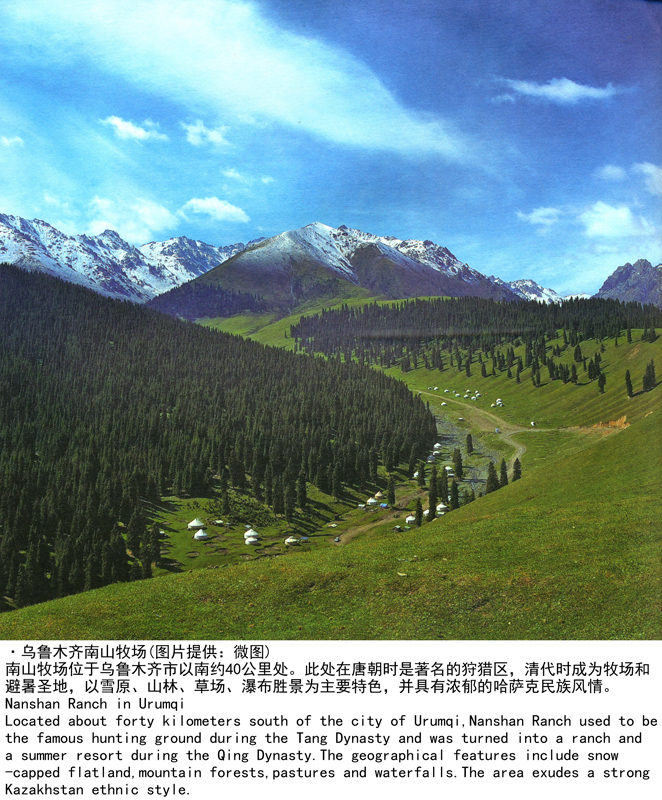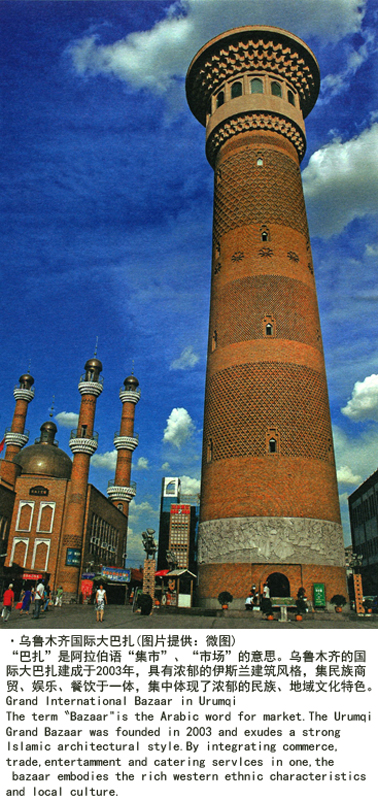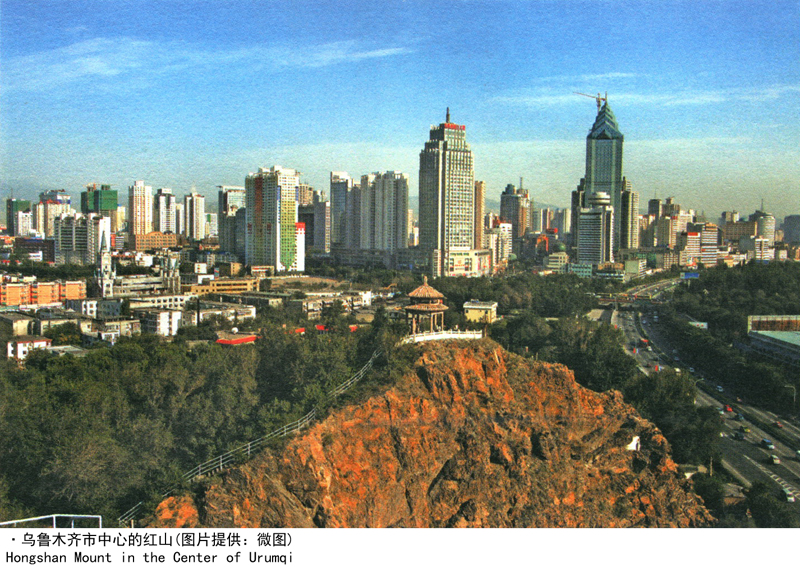丝路概说
- 交通路线
- 长安与丝绸之路
- 从长安到罗马——汉唐丝路全程探行纪实上
- 从长安到罗马——汉唐丝路全程探行纪实下
- 海上丝路史话
- 丝绸之路史研究
- 早期丝绸之路探微
- 早期丝绸之路文献研究
- 中西丝路文化史
- 沧桑大美丝绸之路
- 传播友谊的丝绸之路
- 路途漫漫丝貂情——明清东北亚丝绸之路研究
- 世界的中国——丝绸之路
- 丝绸之路
- 丝绸之路寻找失落的世界遗产
- 丝绸之路2000年
- 丝绸之路——从西安至帕米尔
- 丝绸之路经济带发展报告2014
- 丝绸之路考古十五讲
- 丝绸之路——神秘古国
- 丝绸之路——沿线城镇的兴衰
- 丝绸之路在中国
- 丝路景观
- 丝路起点长安
- 丝路文化新聚焦
- 丝路之光——创新思维与科技创新实践
- 中国丝绸之路交通史
- 中华文明史话-敦煌史话
- 中国·北海合浦海上丝绸之路始发港理论研讨会论文集
- 丝绸之路
- 丝绸之路新史
- 西域考古文存
- 丝绸之路的起源
▲乌鲁木齐
作者:方明



乌鲁木齐是新疆维吾尔自治区的首府,位于天山中段北麓、准噶尔盆地的南缘,是丝绸之路北道上的重镇,东西方经济文化的交流中心。“乌鲁木齐”一词为古代准噶尔蒙古语,意为“优美的牧场”。乌鲁木齐历史悠久,远在新石器时代人类就在这里生息繁衍。战国时期,乌鲁木齐地区属于古车师人的活动范围。西汉时期,乌鲁木齐及其周围地区居住着十几个游牧部落,史称“十三国之地”。西汉初年,朝廷置戊己校尉,在乌鲁木齐近处的金满(吉木萨尔)设营屯田,以维护丝路北道的安全。唐贞观十四年(640),朝廷在天山北麓设置庭州,辖4县,乌鲁木齐一带为轮台县。现乌鲁木齐市东南郊的古城遗址,就是当时的军事重镇轮台城。长安二年(702),庭州又设北庭都护府,轮台的驻军增加。唐代著名的边塞诗人岑参曾在轮台生活过三年,写下了“戍楼西望烟尘黑,汉兵屯在轮台北”的诗句。南宋爱国诗人陆游也曾在诗中写道:“僵卧孤村不自哀,尚思为国戍轮台。”诗中以轮台指代国家的北部边疆,抒发了忧国忧民的爱国情思。
乌鲁木齐的大规模开发始于清代。清政府在此地鼓励屯垦,减轻粮赋,使这里的农业、商业、手工业一度有较快的发展,成为“繁华富庶,甲于关外”的地方。为适应人口增长及商业贸易的需要,清军于乾隆二十三年(1758)在今南门外修筑一座土城,为乌鲁木齐城池的雏形;乾隆二十八年(1763),又将旧土城向北扩展,其周长达到五里。乾隆帝将其命名为“迪化”。清光绪十年(1884),新疆正式建省,清政府设在新疆的军政管理中心由伊犁转到迪化,迪化成为了省会城市。
作为东西方交流的重镇,乌鲁木齐是一个多民族聚居的城市,世居民族有13个。除汉族外,少数民族有维吾尔族、回族、哈萨克族、满族、锡伯族、蒙古族、柯尔克孜族、塔吉克族、塔塔尔族、乌孜别克族、俄罗斯族、达斡尔族等。城市里的每条街道都有少数民族居住,散发着浓郁的民族风情。
>Urumqi
As the capital city of Xinjiang Uygur Autonomous Region,Urumqi lies on the northern foothill of the middle section of the Tianshan Mountain,southern edge of the Junggar Basin.It is a major city on the north route of the Silk Road as well as the center for economic and cultural exchanges between the East and the West.The name〝Urumqi"was an ancient Junggar Mongolian,meaning〝beautiful ranch".The history of Urumqi can be traced back to the Neolithic Age when mankind began to live and thrive in the area.During the Warring States Period,Urumqi belonged to the territory of the ancient Cheshi people.By Western Han,more than a dozen nomadic tribes inhabited in Urumqi and its surrounding areas,that were referred to in history as〝Territory of the Thirteen kingdoms".In early Han Dynasty,the imperial court deployed a troop near Urumqi to safeguard the northern route of the Silk Road.In 640,the imperial court of the Tang Dynasty set up the Ting prefecture north of the Tianshan Mountain to manage the four counties.Urumqi area was under Luntai County,one of the four.The ancient ruins left today in the southeast suburbs of Urumqi used to be the then military town,Luntai.In 702(2nd Chang'an year),the Beiting Frontier Command was incorporated in the Ting prefecture administration.More troops were posted in Luntai.A prominent Tang Dynasty frontier poet who had lived in Luntai for three years wrote the following lines to describe the frontier scene:〝west of the watch towers black smoke rise.Han troops are posted north of Luntai".Another patriotic poet of the Southern Song Dynasty Lu You wrote:〝Lying on my sick bed in an isolated village but I am not sad.I am still thinking about safeguarding the frontier for my country."Luntai referred to the northern frontier and poems expressed the poets'concerns for the fate of the country and their patriotic feelings.
The mass development of Urumqi started in the Qing Dynasty.Relevant policies were promulgated by the Qing government including encouraging settlement,land reclamation,and reducing taxation.As the local agriculture,commerce and handicraft industry enjoyed rapid development,Urumqi became a prosperous city outside the Yumenguan Pass.In 1758(23rd year of the Qianlong reign),in order to meet the requirement of a growing population and trade expansion,local troops built an earth stockade outside the present-day south gate,which became the prototype of the present-day Urumqi fortress.In 1763(28th year of the Qianlong reign),the older earthen fortress expanded further north and reached 2.5 kilometers in perimeter.The newly built city was nominated〝Dihua"by Emperor Qianlong.In 1884(10th year of the Guangxu reign),with the official establishment of the Xinjiang Province,the military and administrative center was moved from Yili to Dihua where it became the provincial capital.
As a major city for exchange and communication between the East and the West,Urumqi is a multi-ethnic city hosting a total of thirteen ethnic peoples.Apart from the Hans,there also inhabit ethnic minorities such as the Uygur,Hui,Kazak,Manchu,Sibo,Mongolian,Kirgiz,Tajik,Tatar,Uzbek,Russian,Daur,etc.Minorities can be found on every street.The entire city demonstrates a strong ethnic style.
丝绸之路/方明编著.-合肥: 黄山书社, 2013;